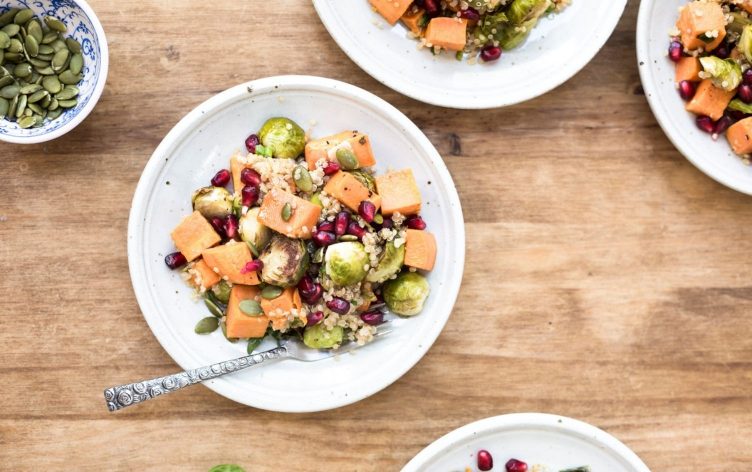
Why Is Fiber Important and How to Incorporate it Into Your Day
Fiber is the unsung hero for creating lasting health! It helps to keep our gut microbiome healthy, removes waste from the body, and helps us maintain a healthy weight. Not only that, when you regularly get enough fiber in your diet, it can help lower your risk of diabetes, heart disease, stroke and all types of cancer.
With all of those great benefits, we should definitely pay more attention to fiber!
WHAT IS FIBER?
Fiber is an indigestible carbohydrate. Unlike other nutrients, fiber passes through the digestive tract relatively undigested. Fiber is only found in plant-based foods. Animal products (i.e., fish, chicken, meats, dairy, etc.) do not contain fiber.
There are two types of fiber found in plants: soluble and insoluble. As a general rule, soluble fiber is found inside the plant and insoluble fiber is found on the outside. For example, the skin of an apple is insoluble fiber, and the flesh is soluble. Most fiber-rich foods are made up of both types, but the body uses them differently.
SOLUBLE FIBER
Soluble fiber dissolves in water and other bodily fluids. As it moves through your digestive tract, it absorbs water and creates a gel-like substance. Once it gets to the colon, it’s fermented by bacteria. This process helps produce short chain fatty acids like butyrate, which improve overall gut health and provide fuel for your gut cells.
These include:
- Stabilizing blood glucose levels
- Lowering LDL and total blood cholesterol
- Increasing fullness and delaying hunger
- Improving gut health and immunity
CLICK TO TWEET THIS ARTICLE > This RD explains how fiber is important for lasting health and shares some simple ways to include more fiber in your diet via @MyFitnessPal #myfitnesspal
INSOLUBLE FIBER
Insoluble fiber does not dissolve in water, but absorbs it, helping to form softer, bulkier stools and improve elimination. While insoluble fiber is not fermented by bacteria in the colon, it still has positive effects on gut health. It helps reduce your risk for constipation, hemorrhoids, diverticular disease, and some forms of colorectal cancer.
HOW MUCH FIBER SHOULD YOU GET?
According to the Academy of Nutrition and Dietetics, the recommended intake for dietary fiber in a 2,000 calorie diet is 25 grams per day for adult females and 38 grams per day for adult males. That said, some people can easily handle higher intake, while others may have health conditions requiring less.
Using an app like MyFitnessPal, you can track your daily fiber intake. This not only helps you determine your average intake, but you can also see which of your favorite foods is highest in fiber. Once you know this, you can make sure to add them to each meal. If you notice you’re not getting in enough fiber, start adding it in slowly and work your way up. Too much fiber too fast can cause gas, pain and bloating. To prevent constipation, be sure to drink enough water each day, especially when adding more fiber to your diet!
FOOD SOURCES OF FIBER
SOLUBLE FIBER
- Most beans
- Chia seed
- Flaxseed
- Hemp seed
- Brussel sprouts
- Avocado
- Sweet potato
- Broccoli
- Berries
- Pears
- Figs
- Dried fruit
- Apples
- Oats
- Barley
INSOLUBLE FIBER
- Bran cereals
- Fruits with seeds and edible skin (like berries, apples, etc)
- Beans and lentils
- Corn
- Green peas
- Okra
- Spinach and other leafy greens
- Most whole grains
IDEAS FOR INCORPORATING FIBER
Getting your daily intake of fiber isn’t all that hard if you spend some time meal planning. Getting in a serving of fiber with each meal is easy when you focus on high-fiber, nutrient-dense carbohydrates.
Some tips for increasing fiber:
- Eat fruits and vegetables with their skins on (eat your potato skin!).
- Add beans to your salad.
- Sprinkle seeds like hemp or flax onto salads or stir into soups.
- Add chia seed to smoothies (or make chia seed pudding!).
- Replace pasta with whole-wheat or bean-based versions.
- Choose breads, rolls and wraps that have at least 5 grams of fiber per serving.
- Bake with high-fiber flours (chickpea, buckwheat, barley and coconut).
This sample meal plan contains 38 grams of fiber:
Breakfast
1/2 cup of oatmeal topped with sliced bananas and 1/4 cup of crushed walnuts
Lunch
3 cups of green salad with chopped vegetables,1/2 avocado, 1/2 cup black beans, and grilled chicken breast, tossed with a vinaigrette dressing. Served with a sliced apple
Snack
1 cup of carrot sticks or bell peppers
2 tablespoons hummus
Dinner
Broiled salmon filet with 1 cup of roasted broccoli and a baked sweet potato
THE BOTTOM LINE
Getting enough fiber in your diet has been linked to lower rates of obesity, heart disease, stroke, diabetes, and all cancers. A diet rich in vegetables, nuts, seeds, legumes and whole grains is naturally high in fiber. Adopting a high-fiber diet can also help manage weight by keeping you full between meals, reducing cravings and curbing appetite.





